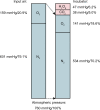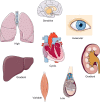Frequently asked questions in hypoxia research
- PMID: 27774480
- PMCID: PMC5045069
- DOI: 10.2147/HP.S92198
Frequently asked questions in hypoxia research
Abstract
"What is the O2 concentration in a normoxic cell culture incubator?" This and other frequently asked questions in hypoxia research will be answered in this review. Our intention is to give a simple introduction to the physics of gases that would be helpful for newcomers to the field of hypoxia research. We will provide background knowledge about questions often asked, but without straightforward answers. What is O2 concentration, and what is O2 partial pressure? What is normoxia, and what is hypoxia? How much O2 is experienced by a cell residing in a culture dish in vitro vs in a tissue in vivo? By the way, the O2 concentration in a normoxic incubator is 18.6%, rather than 20.9% or 20%, as commonly stated in research publications. And this is strictly only valid for incubators at sea level.
Keywords: Krogh tissue cylinder; gas laws; hypoxia-inducible factor; oxygen diffusion; partial pressure; tissue oxygen levels.
Figures





Similar articles
-
[Protective effects and mechanism of keratinocyte growth factor combined with hypoxia inducible factor-1α on intestinal crypt epithelial cells of rats with hypoxia stress].Zhonghua Shao Shang Za Zhi. 2019 Jan 20;35(1):54-61. doi: 10.3760/cma.j.issn.1009-2587.2019.01.010. Zhonghua Shao Shang Za Zhi. 2019. PMID: 30678402 Chinese.
-
Controlling pericellular oxygen tension in cell culture reveals distinct breast cancer responses to low oxygen tensions.bioRxiv [Preprint]. 2023 Oct 3:2023.10.02.560369. doi: 10.1101/2023.10.02.560369. bioRxiv. 2023. Update in: Adv Sci (Weinh). 2024 Aug;11(30):e2402557. doi: 10.1002/advs.202402557. PMID: 37873449 Free PMC article. Updated. Preprint.
-
Analysis of oxygen delivery and uptake relationships in the Krogh tissue model.J Appl Physiol (1985). 1989 Sep;67(3):1234-44. doi: 10.1152/jappl.1989.67.3.1234. J Appl Physiol (1985). 1989. PMID: 2793716
-
Limitations of oxygen delivery to cells in culture: An underappreciated problem in basic and translational research.Free Radic Biol Med. 2017 Dec;113:311-322. doi: 10.1016/j.freeradbiomed.2017.10.003. Epub 2017 Oct 13. Free Radic Biol Med. 2017. PMID: 29032224 Free PMC article. Review.
-
Systemic Oxygen Transport with Rest, Exercise, and Hypoxia: A Comparison of Humans, Rats, and Mice.Compr Physiol. 2018 Sep 14;8(4):1537-1573. doi: 10.1002/cphy.c170051. Compr Physiol. 2018. PMID: 30215861 Review.
Cited by
-
A reliable set of reference genes to normalize oxygen-dependent cytoglobin gene expression levels in melanoma.Sci Rep. 2021 May 25;11(1):10879. doi: 10.1038/s41598-021-90284-6. Sci Rep. 2021. PMID: 34035373 Free PMC article.
-
Anti-breast cancer and anti-angiogenic potential of a lichen-derived small-molecule: barbatolic acid.Cytotechnology. 2018 Dec;70(6):1565-1573. doi: 10.1007/s10616-018-0249-x. Epub 2018 Aug 28. Cytotechnology. 2018. PMID: 30155608 Free PMC article.
-
Comparison of specific expression profile in two in vitro hypoxia models.Exp Ther Med. 2018 Jun;15(6):4777-4784. doi: 10.3892/etm.2018.6048. Epub 2018 Apr 10. Exp Ther Med. 2018. PMID: 29805495 Free PMC article.
-
Cellular Pre-Adaptation to the High O2 Concentration Used in Standard Cell Culture Confers Resistance to Subsequent H2O2-Induced Cell Death.Antioxidants (Basel). 2024 Feb 22;13(3):269. doi: 10.3390/antiox13030269. Antioxidants (Basel). 2024. PMID: 38539802 Free PMC article.
-
Whole transcriptome data of primary human NK cells under hypoxia and interleukin 15 priming: A 2×2 factorial design experiment.Data Brief. 2017 Jul 15;14:77-83. doi: 10.1016/j.dib.2017.07.018. eCollection 2017 Oct. Data Brief. 2017. PMID: 28795085 Free PMC article.
References
-
- Klinke R, Pape H-C, Kurtz A, Silbernagl S. Physiologie. 3 ed. Stuttgart, Germany: Georg Thieme; 2010.
-
- Groebe K, Vaupel P. Evaluation of oxygen diffusion distances in human breast cancer xenografts using tumor-specific in vivo data: role of various mechanisms in the development of tumor hypoxia. Int J Radiat Oncol Biol Phys. 1988;15:691–697. - PubMed
-
- Olive PL, Vikse C, Trotter MJ. Measurement of oxygen diffusion distance in tumor cubes using a fluorescent hypoxia probe. Int J Radiat Oncol Biol Phys. 1992;22:397–402. - PubMed
Publication types
LinkOut - more resources
Full Text Sources
Other Literature Sources

